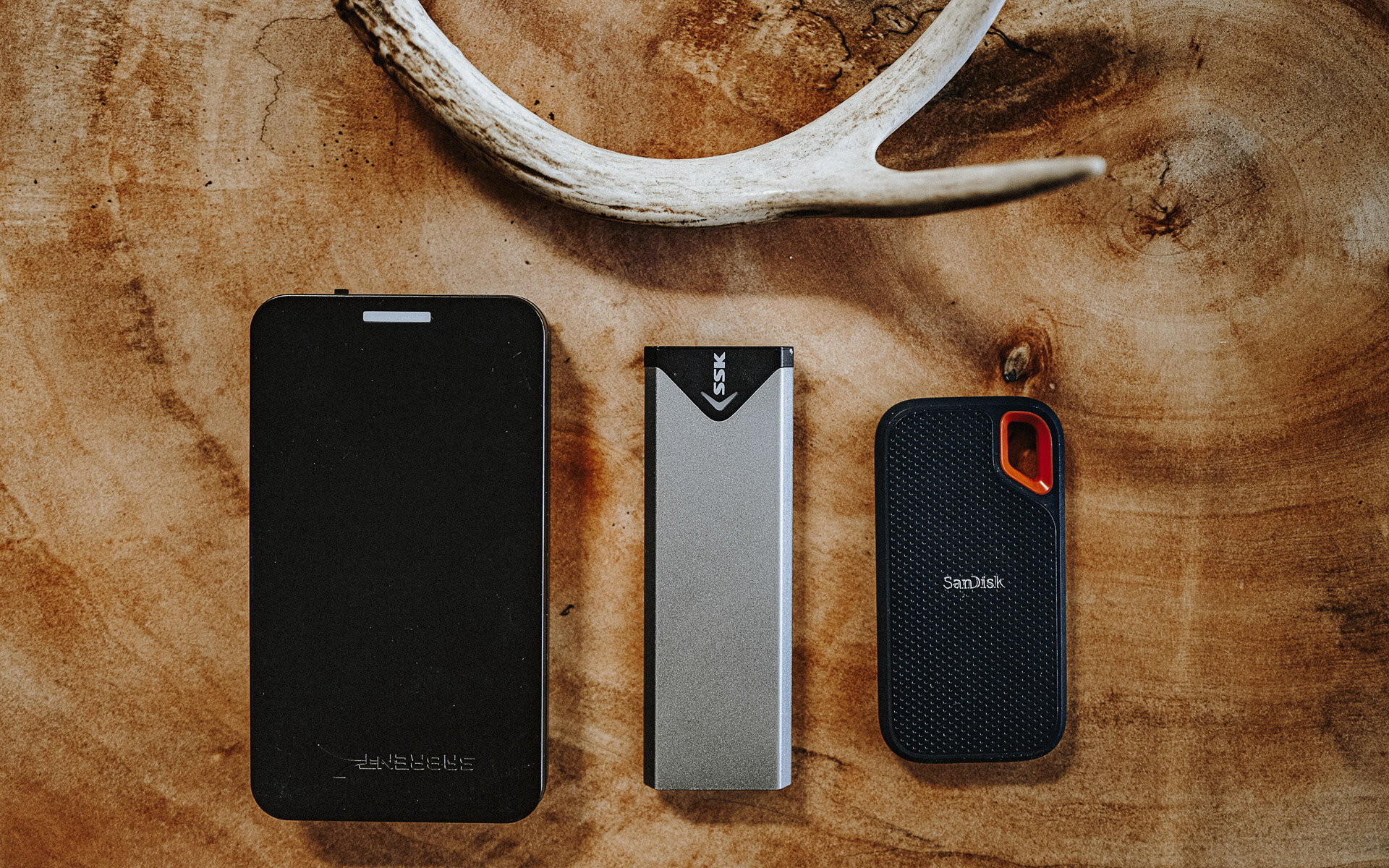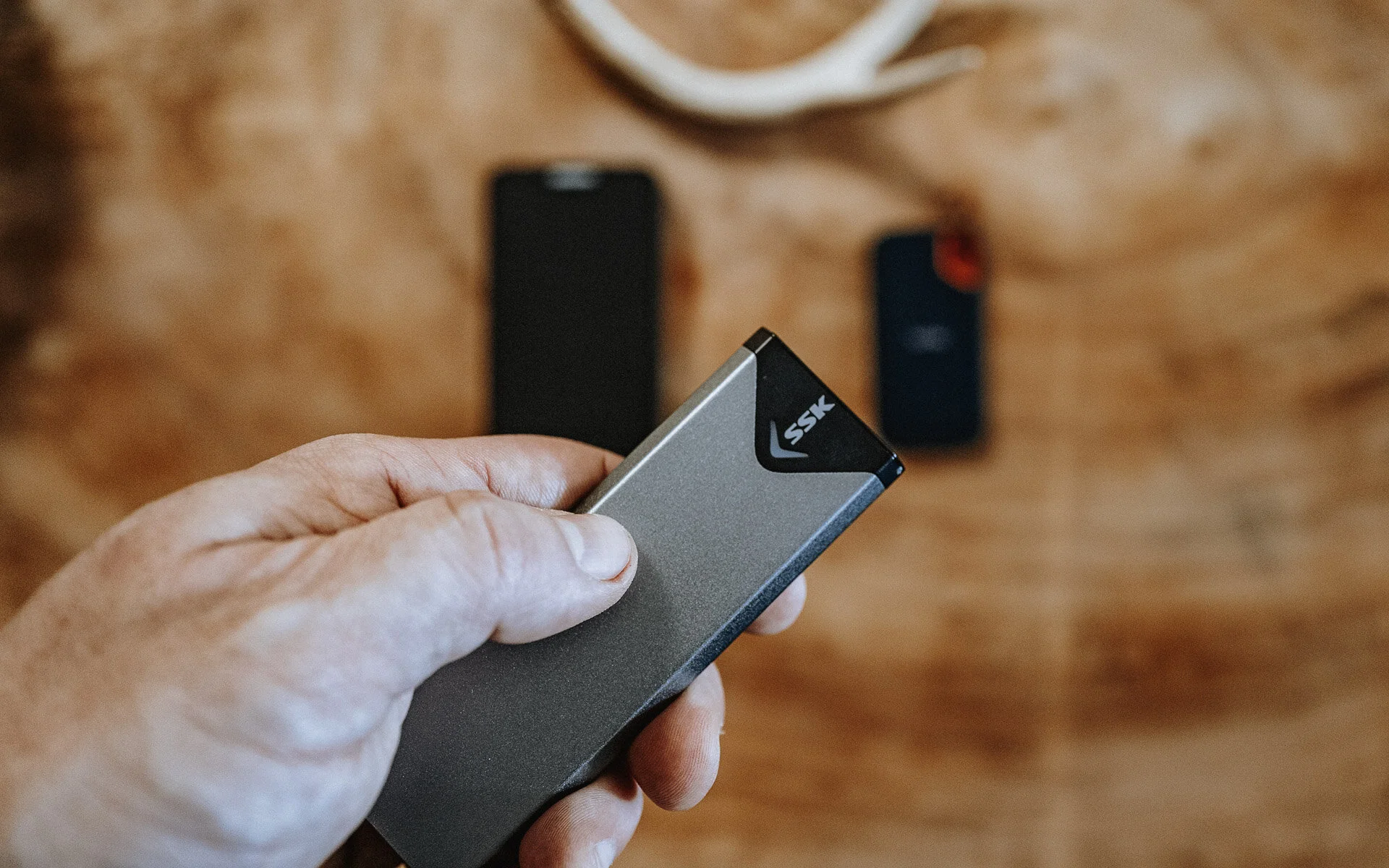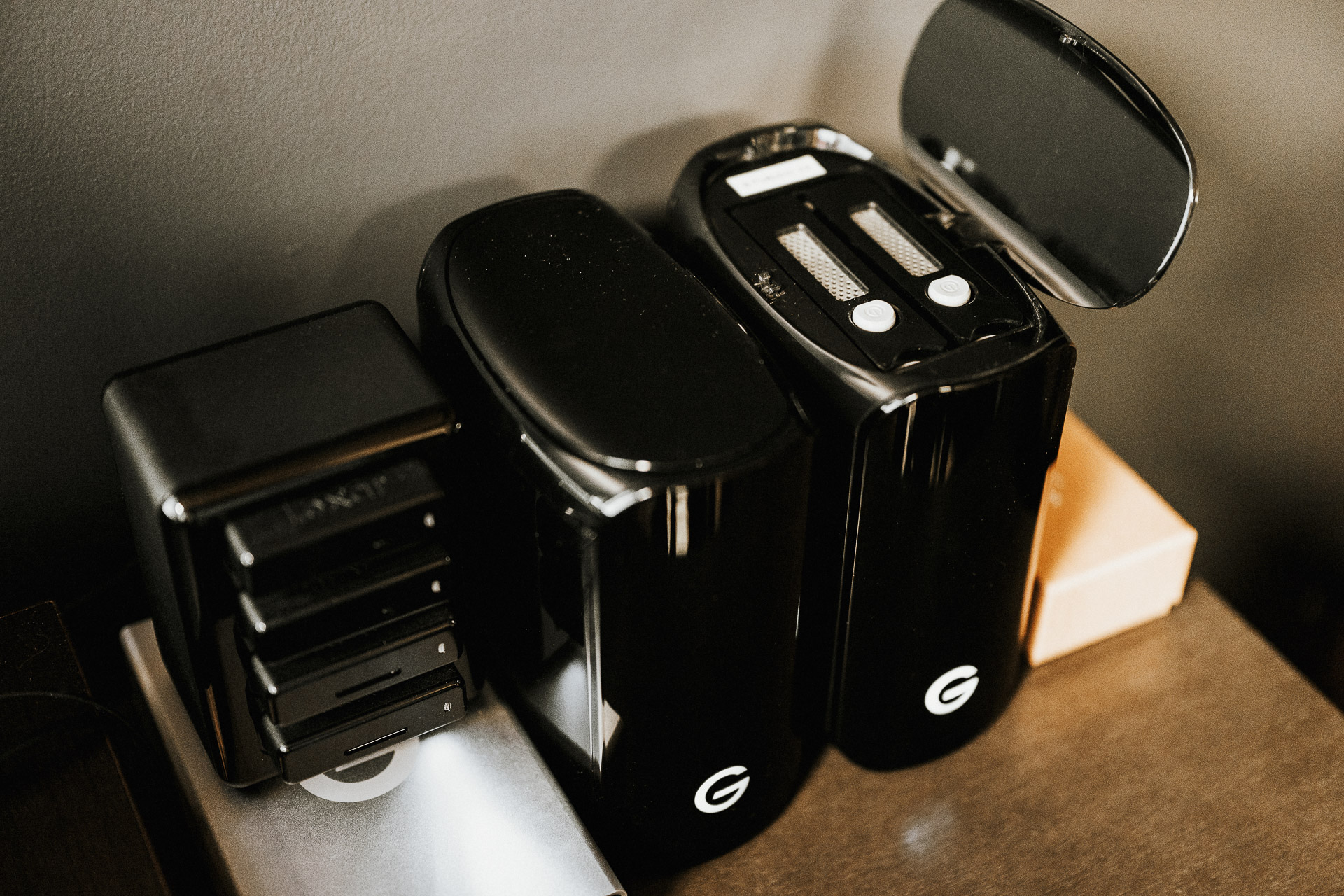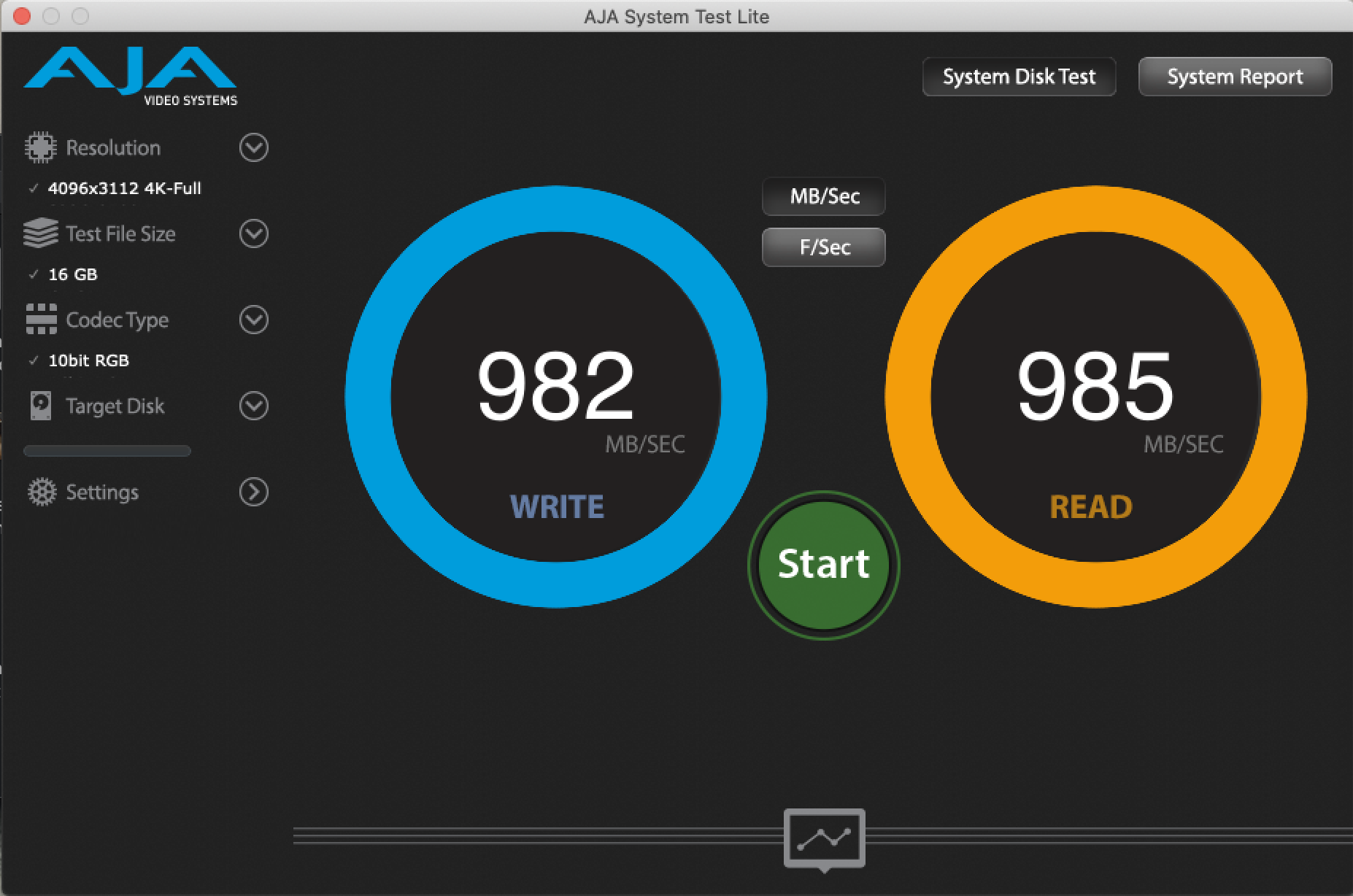The SSD Hype - Why Pay More For Less Storage?
(ABOVE) The first 4 external hard drives from left to right are HDD’s. The last one all the way on the right is a 1TB SSD with SATA III connection in a Sabrent Housing that uses a USB 3.0 connection. (BELOW) Three more popular SSD options on the market right now. The one in the middle is not only the fastest (by far) but also the one that I will be recommending by the end of this article.
LEFT: SSD Sata III 2.5” - MIDDLE: SSD M.2 NVMe - RIGHT: SanDisk Portable USB 3.1 Type-C External SSD
INTRODUCTION
Along with all the exciting tech advancements in cameras these past few years, there’s also been some pretty nice advancements in the storage department. While it’s tough enough to keep up with all the new camera tech that has saturated the market with all of the mirrorless hype over the past couple of years, let’s be honest, at least that’s exciting as gear junkies. It’s been an exciting few years in terms of technology advancements with cameras, but there’s been some pretty impressive advancements in storage devices as well. With camera tech being front and center, the less exciting advancements with storage devices have received a lot less love. Let’s be honest, it can be a little more difficult to understand the terminology, making it easier to simply stick with the hard drives you’re currently using.
The downside is, those will fail, and if you don’t have the proper back up plan in place it can be devastating if one does. The other advantage to understanding the new advances in storage technology and equipment is speed. Understanding the difference between an SSD and an HDD, the advantages and disadvantages to each can basically change your workflow in many positive ways giving you back time that you can put towards spending with family or whatever it is you would rather be doing than staring at a progress bar. I can ask any random photographer about the new mirrorless bodies that have been released in the past year and most will be able to tell me. I can ask the same photographers if they would rather have a 1TB SSD external drive or a 2TB HDD for a lot less money, most either won’t know the difference or will simply pick the cheaper one.
THE BASICS
While I get it, learning about storage is pretty damn boring and when you have an extra grand to put towards gear, it’s a lot more tempting to put that towards a new lens or new lighting gear. What you need to understand is that you don’t want to have a hard drive fail on you, regret not implementing a solid backup plan before hand, and now you’re forced to do so in a panic before it happens again. That’s the reality of this business. Hard drives fail, memory cards fail, and while recovery software is getting better it can only do so much and typically can’t save your ass. If you don’t have a solid back up plan in place, you aren’t alone I promise. I talk to photographers all the time who still don’t have (at least) a general understanding of what a solid 3-2-1- backup solution is OR simply don’t know the difference between an SSD or an HDD. So, before we go any further, let’s just get part of that out of the way right out the gate.
(UPDATE - March 2020) One thing that I should mention here, since I only briefly mention it at the end, is that there are several types of connectors that SSDs (Solid State Drives) can have, each offering different speed advantages at obviously different cost points. Since writing this last year, this SSD type that dropped enough in price to make it well worth it for those who, like me, see the value in the speed boost that will bring you up to 10gbps. A pretty impressive jump from the SATA III SSDs as you’ll see further down in this article. They’ve drastically dropped in price, as well as the housings for them which have given us even more options at prices that were way too high for simply one advantage, speed.
SSD:
Solid State Drive (think flash drive - No moving parts)
HDD:
Hard Disk Drive (moving parts)
I’ve written a few articles now on good backup and storage practices to avoid data loss, here are two of them: My New 10G Studio Network & The 3-2-1 Rule. I’m not going down that road again with this article, instead focus on explaining why you really should pay attention to the SSD hype and why it’s important. I’ll also be giving an explanation as to what the differences are between SSDs and HDDs as well as the advantages/disadvantages of each in an easy to understand way. With that being said, as creatives and visual thinkers, I always like to show how I’m personally using the subjects of my article, in this case - HARD DRIVES.
Over the past 5 years or so, SSD’s really started making their presence known as an option over HDD’s as internal storage for the operating system in computers. Yes, they were around earlier than that, but it was roughly 5-6 years ago that they started making their presence known, especially in the creative industry. At first, they came onto the scene as a pricier option for internal storage in PC’s and not so much as external drives being thrown in pockets and carried around like an SD card. Going with the option of an SSD in your computer initially offered more speed, less power consumption, and less noise due to there being NO moving parts. The same advantages that SSD’s offer as external drives as well, but either way, they come at a price. However, as of today, almost all new PC’s (whether it be a MAC or Windows machine) are using SSD’s for internal storage. The good news is that the price has been dropping significantly over the past several years, even more so since early 2018. The forecast for remainder of 2019 and early 2020 is that they’ll drop close to another 50% more. The flip side of that coin is that SO WILL the HDD’s which aren’t going anywhere anytime soon. In 2012, a 512Gb SSD cost $400. Now, you can get Samsung 1TB SSD for $147.99.
(UPDATE - March 2020)
Prices for SSD’s have dropped a lot more since April of 2019, just about a year ago. With the price drop, SSD’s with a connection type that I only briefly mentioned at the end of this article, the M.2 SSD have quickly become the way to go when it comes to portable external drives. Just before writing this article in 2019, I had purchased the Samsung 1TB SSD (an EVO SATAIII 2.5”) for $169.99, they are now $147. While that price hasn’t dropped a ton, it’s still over a $20 difference. The price for the SanDisk 1TB Extreme USB3.1 Type-C is still sitting comfortably at $169.00. BUT, HERE IS THE BIG CHANGE - The 2TB INTEL NVMe M.2 SSD with SSK Aluminum M.2 NVME SSD Enclosure Adapter, USB 3.1 Gen 2 (10 Gbps) which is smaller and while also providing 10Gbps speeds is only $299. You can see how much of a difference that actually is when compared to the SATAIII SSDs.
THE IMPORTANCE
Why does this info hold any importance to those not looking to invest in a new computer or upgrading one? With the price drop of both SSDs and HDDs over the past few years, SSD’s have broken their glass ceiling and started making their way outside of computer housings and into external drives. Companies like SanDisk, Samsung, Lacie, and G-Tech are making portable external SSD drives. These drives are much smaller, faster, and more durable than typical external HHD drives that photographers have been using for years. Because of their smaller size, two of them can be stacked on top of each other in an enclosure the same size as a typical HDD external hard drive that we’ve all been used to using for years. Two SSD’s in an enclosure, with read/write speeds much faster, USB 3.1 Type C or even Thunderbolt 3 for Mac users, and the ability to run a RAID for even more protection. I don’t know about you, but that’s pretty damn impressive to me and a sign of what’s to come in terms of protecting our data/images as the prices of SSD’s go down and the capacity goes up. No more having to feel like you might vomit after dropping an external hard drive that isn’t backed up anywhere else.
The 2TB NVMe M.2 SSD held in my hand to show size.
SSD vs HDD
I’ve had one too many conversations with other photographers who simply look at the total amount of storage, bus power (type of connector such as USB or Thunderbolt) and the price when shopping for a new external drive. To be fair, up until a year or so ago, that was basically all that did matter. Most know that if they have a Mac, Thunderbolt is faster than USB. After that, it’s simply comparing prices for the amount of storage they’re looking for. Well, times are changing and depending on your needs, it might be time to start spending more on a 1TB SSD external drive than a 3TB HDD external hard drive. SSD’s are basically replacing HDD’s and if you don’t know the difference, now is the time to start getting caught up. Below is a comparison of the two, and why some may want to spend more on an SSD. For me, I still use both.
While 2TB portable SSD external drives are still on pricey side, 2019 will be the year you’ll see that change (which we did if you’re reading this now in 2020). 1TB sized drives have been the more popular choice. It makes more sense to go with a 1TB portable to carry with you while still utilizing the cheaper HDD drives in the studio to transfer your data to for safe keeping and backing up. I just picked up a few 10TB 7200rpm HDD’s for my NAS that cost $300. I picked up three individual 1TB SSD’s for $150 each. For me personally, if the drives are in the studio and aren’t in danger of falling or being dropped, total storage and going with a reliable brand is my main concern. For portable drives, I’ve dropped way too many external drives to risk having one of those internal moving parts get knocked around causing data loss. I typically don’t need anything more than 1TB when on the road traveling, although I’m looking forward to the prices dropping on the 2 and 3TB drives this year.
THE FUTURE
In August of 2017, Samsung released the first USB-C portable SSD available to the consumer. They had a couple previous models that were a different type of of SSD (I won’t get into the different types in this article), but 2017 was the year when portable SSD’s with both USB and USB-C interfaces hit the market. I purchased the SanDisk portable 1TB SSD Extreme when it came out last year and loved it. However, earlier this year, it grew legs and made a break for it. With prices dropping and seeing the trends in storage this coming year, I went a different route for my portable SSDs. I purchased a 4-Bay enclosure that is directly connected to my main workstation (2017 iMac Pro) so it can be added to the Backblaze Cloud Storage like the other external drives. The SSD’s are hot swappable which also makes it easy to pop one out, toss it into an enclosure like the one below to bring home or on the road with me. I also picked up the Mediasonic ProRaid USB-C 2 Bay enclosure that can run RAID1 for extra protection. Dual drives being a mirror of one another in case one was to fail.
SSD RAID Enclosures
The Mediasonic Pro RAID which holds two SATA III 2.5” SSDs is one of my favorite portable drives that I own. Now that the prices have dropped on the 2TB Samsung 860 EVO SATA III 2.5" SSDs, I’ve replaced the 1TB drives giving me double the storage at a pretty reasonable price. No, you don’t need to have an external drive that runs RAID, but for me, it gives me that little extra piece of mind that if one fails while out in the field or on the road, the other drive will have everything I need. With a USB Type C connection that offers close to 5Gbps as you’ll see below, it keeps up with basically all the SATA III connection SSDs while also giving me that mirroring RAID1 setup.
Since writing this, there have been a few other enclosures that offer a similar dual drive setup that have the ability to run RAID0 or RAID1. I would list them here but honestly, this article is already long enough and this is the only one that I’ve personally tried.
Mediasonic ProRAID USB-C 2 Bay - USB-C - A peek at the inside.
LETS TALK SPEED
With one of the biggest advantages (if not the most important) of SSD’s over HDD’s being speed, let’s take a look at some of the speed tests I’ve ran. Hopefully, if you’ve read everything up to this point you have a much better understanding of why SSD’s have been receiving so much attention. You should also see the advantages that come along with a much smaller and robust drive that has no moving parts that can easily break if dropped, yet nearly twice the price. For most, speed is everything, it means less time spent sitting at a workstation in front of a monitor or a laptop and leaving more time for other things. Possibly, even time spent using an actual camera capturing your own moments with family or friends.
Personally, I’m willing to spend more money for extra speed. Time IS money after all, and the less I have to stare at a progress bar or spinning pinwheel the more I’m willing to dish out. I’ve upgraded the studio’s to a 10Gbe network and have now began replacing all my portable external drives with new SSD options. The plan is to also start implementing the faster SSD’s with our associate photographers making it much quicker for them to transfer their files over to our main server from their home RAID setup that we provide them.
[Twisted Oaks 10Gbe Network Breakdown]
I remember installing my first 2-bay HDD RAID setup just about 4 years ago and being happy and relieved to have that extra level of protection. Now, I have a portable external enclosure that holds dual SSD’s running RAID1 that’s overall smaller in physical size than most of my portable HDD drives. Most don’t even know these are out there.
So, if you don’t mind the longer wait times while uploading or downloading data there’s no need to go any further. Below, I’ve shared the speed tests I’ve ran to which show the the speed advantages of both the Samsung 1TB 860 EVO SATA III SSD and the SanDisk 1TB Extreme Portable SSD (the two 2.5” SSD drives that I personally have invested in) using USB3.1 (TypeC) over the popular HDD alternative drives with more storage at a much cheaper price per TB.
SSD SPEED TESTS
Samsung 1TB SSD inside the portable Sabrent SATA USB-3.1 Enclosure
HDD SPEED TESTS
(This is where the price difference comes into play the most between SSDs and HDDs)
G-Technology GRAID Thunderbolt2
G-Technology GRAID Thunderbolt2
CONCLUSION
(UPDATED in March 2020)
I’ve had this blog post sitting in the queue basically marinating for the past couple months as I’ve been busy with other projects. I had contemplated on tossing it but in the two months that it’s sat waiting to be finished, I’ve had more photogs question the advantages of SSDs over HDDs and also invested more of my own money into SSD related products. So, after a 5-day long stint in the hospital last week I had a little time to spare. Time used to finally get this conclusion written up.
While SSD’s are faster, more durable, and quickly dropping in price, HDD’s aren’t going anywhere anytime soon. The price per TB of storage with HDDs is also continuing to drop, making large amounts of storage affordable for those who need it. I recently purchased a 24TB G-Technology G-RAID with Thunderbolt3 for the same price that I bought a 12TB G-RAID with Thunderbolt2 just 4 years ago. Now, due to the price of HDD storage I’m able to afford two Synology NAS devices with a total of close to 100TB’s of storage. Storage that I can upload and download to at pretty fast speeds even with HDDs running in each NAS due to the 10Gbe cards and wiring.
If this article has piqued your interest in utilizing SSDs and would really love to take advantage of the all that extra speed that available to us now, I’ll give you my top 3 recommendations below. With the rate at which SSD prices continue to drop I have no doubt that the NVMe M.2 SSD is going to be the way to go for the next couple of years in both internal and external drives over the SATA III 2.5” SSDs. Since I didn’t get very technical at all in this article I highly suggest reading up on the differences between an SSD with an M.2 NVME interface, SATA, or PCIe connection type.
The first SSDs that I purchased to use as external drives were the SATA III 2.5” Samsung drives which were an awesome step up in speed compared to my other external drives. Sure, they were a quarter of the storage that some of my other, slower, HDD externals had but I used both. About 8 months after writing this article and publishing it in April of 2019, the NVME M.2 SSDs started dropping in price and companies jumped on the opportunity to start making USB-C interface enclosures making them even more enticing. With speeds as close as you can get to 10Gbps, double of the SATA III SSDs, and smaller enclosures, the M.2 drives are the way to go for those speed maniacs like myself.
I am still using HDDs for my NAS enclosures and working RAID enclosures like the G-RAID 24TB that I have running right next to my desk which has a Thunderbolt3 connection to my iMac Pro. Since I just checked to see what the price currently is for the G-RAID that I have, I noticed that it’s been discontinued and is no longers available. If you are looking for a large dual drive RAID like mine that you can run RAID1 (mirrored drives) as a working drive, I recommend this 20TB G-RAID or this 28TB G-RAID Thunderbolt3.
No matter what, it’s exciting to see the new technology that’s will be coming out in 2020 and 2021 as well as the once unaffordable technology that’s dropping drastically in price. Yes, I used the word exciting and storage in the same sentence, you read that correctly. I’m a geek, what can I say. The less I have to stare at a progress bar while waiting for uploads is exciting. We now have a lot more options available to us at much more affordable prices.
For right now, having a general understanding of SSDs and HDDs is enough to help you make smarter purchasing decisions based on your storage needs. That’s the reason I wrote this up and hopefully, it helps.
Thank you for reading! Please leave any questions below.































